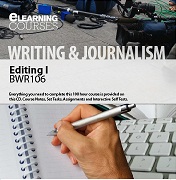Train as an Editor or Proofreader
 Study by remote learning.
Study by remote learning.
- Become a skilled editor and proofreader
- Advance your career opportunities
- Gain a highly transportable and widely valued skill
Copy editing and proofing (proofreading) are two different processes.
- Proofreading involves reading over and correcting a manuscript AFTER the pages have been laid out. It also involves reading images taken from the artwork to ensure that they appear as intended.
- Copy editing is one stage before this. It involves reading over a manuscript that is in its final form (or close to final form), correcting textual errors, and ensuring the writing is logical and lucid. The copy editor also marks up typographical instructions for the production staff who have the task of creating the images that will be seen on each page.
Save
Save
Modules
Note that each module in the Qualification - Certificate in Editing is a short course in its own right, and may be studied separately.

What do our students think of our writing courses?
"I commenced the Creative Writing Course with the ACS
having had no prior experience in this field whatsoever. Having always
been in accounting or payroll jobs, I decided to give the course a go.
The course demonstrated to me what I enjoyed writing about, the types of
writing I was good at, and not so good at. It broadened my horizon to
show me what was out there to write about. It gave me knowledge and
confidence. I have continued to write, and in the future want to
commence with the next course, but in the meantime, I have submitted
various articles of mine to some magazines and have had nothing but
positive feedback from all the editors and some of my work is to be
published!! Which I personally feel is fantastic as I have only been
doing this for a year or so. Thank you for opening up a whole new world
of creativity to me which I can only enhance upon!!"
- Jo
Becoming an Editor or Proofreader
Being a successful journalist is as much dependent upon you “working to specification” as it is, being a competent writer. Either one without the other can lead to career failure at worst, and an inability to reach your full potential at worst.
When editing your work, you should look at both the appropriateness of the content, the clarity of the language, and the style. When editing for online publication, you must also consider some factors that have been traditionally more important in advertising copy than in other writing, such as immediate visual impact, grabbing the reader’s attention, and otherwise making your work stand out and catch the attention of readers who may not be looking for what you write, or who are selecting from an enormous range of reading options.
Editing and proofreading are exciting careers. You need good attention to detail and the ability to work to tight deadlines.
A high level of written and spoken communication skills are also important, as is a love of language.
Does this sound like you? If your answer is yes, why not enrol today and start your career in editing? Or set up your own business?
You can enrol on the course now, but if you have any questions about the content of the course or studying with ACS, then please get in touch with us today - use our FREE COURSE COUNSELLING SERVICE to get in touch with our expert tutors. They will be pleased to help you!
Save
Save
